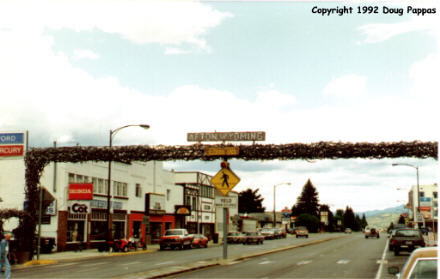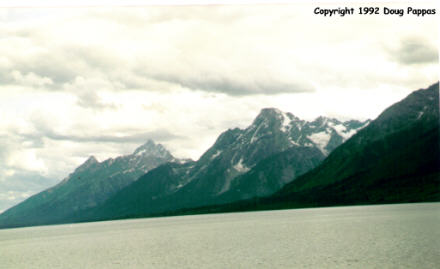Monday, July 13, 1992...
Between Ogden and Brigham City, 89's known as the Fruitway -- a swift-moving, four-lane road lined with orchards and fruit stands. I turned west at Brigham City, detouring 29 miles to the Golden Spike National Historic Site, where the transcontinental railroad was completed in 1869. The Site has an uninspiring film on the event it commemorates; a historic marker which was moved a hundred yards away from the actual site where the Golden Spike was driven; and, fortunately, two full-sized replicas of the Union Pacific and Central Pacific locomotives used that day. The original railroad beds, from which the tracks were removed long ago, can also be driven.
I returned to Brigham City, turning northeast toward Logan. US 89's joined here by US 91, an old road which had almost suffered the fate of Route 66. Originally known as the Arrowhead Highway, it once ran from the Canadian border to Los Angeles, but I-15 has almost totally displaced it. The two roads split at Logan, with 89 continuing northeast through scenic Logan Canyon into southeastern Idaho, then southwestern Wyoming. In Montpelier, Idaho, it unites with US 30 for about three blocks -- it was nice to see that old friend again.

But not so nice to see the next town on the route: Jackson, Wyoming, the yuppie's Gatlinburg. With J. Crew, Ralph Lauren and Benetton outlet stores, not to mention dozens of other establishments with names too cute for words, Jackson's my idea of a Western hell on earth; the number of people who so evidently did not share my contempt only reinforced some of my worst opinions of my fellow Americans.
Nothing, though, could ruin the Grand Teton National Park, which features the most dramatic mountain range in America. The peaks of the Teton Range rise abruptly, almost vertically, on the west side of the park, towering a mile above the Jackson Hole basin. (The mountains were named by French explorers who'd been away from home so long that they thought the mountains resembled a row of giant breasts.) From the south, I passed the National Elk Refuge, then a tiny pioneer-settlement exhibit called the Cunningham Cabin, with beautiful views and abundant vegetation in all directions. An even better view is available inside theChapel of the Transfiguration, where a plate-glass window behind the altar frames the mountains like a 10' x 20' postcard. For a higher perspective, the summit of Signal Mountain, accessible from a loop road, allows visitors to look across at the Tetons and down on Jackson Hole below.

No thanks to the underpowered RVs clogging the roads, I continued north into Yellowstone National Park. I drove straight to the Canyon Lodge area of Yellowstone, arriving shortly after 8:00. I checked into the lodge, then grabbed dinner and wandered around the four or five souvenir-and-provisions shops before finding my cabin and settling in for the night. No TV, no radio, no phone - and no excuses for not sleeping well...
Go to the next dayBack to Old Road Trips menuBack to ROADSIDEPHOTOS.COM home page